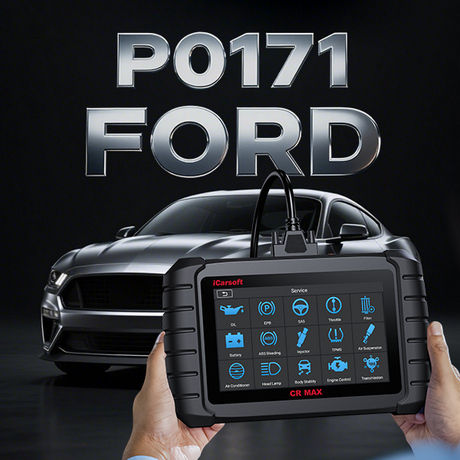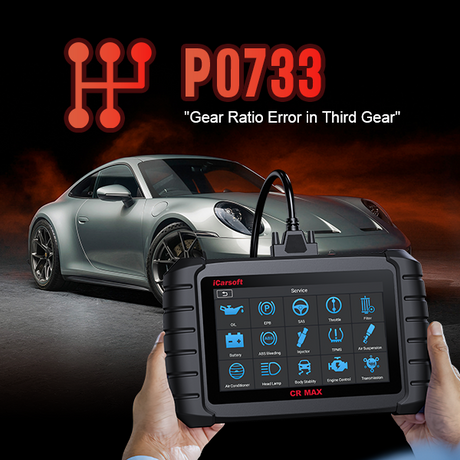Table of Contents
- 1. The meaning of the P0159 code
- 2. Possible causes of the P0159 code
- 3. Common symptoms of the P0159 code
- 4. Which vehicles can trigger the P0159 code?
- 5. Severity of the P0159 code
- 6. Can I still drive if the P0159 code appears?
- 7. How can I solve the P0159 code problem myself?
- 8. How to diagnose the P0159 code?
- 9. How much does it cost to repair the P0159 code in the United States?
- 10. How to clear the P0159 code?
- 11. How to prevent the occurrence of the P0159 error code?
- 12. Other considerations for the P0159 code
- 13. How to Choose a Diagnostic Tool?
In the complex system of modern cars, OBD2 (On-Board Diagnostics Second Generation) plays a vital role. It not only monitors the operating status of the vehicle in real time, but also generates specific fault codes when a fault occurs, helping technicians quickly locate the problem. Among them, the P0159 code is a common one in the OBD2 system. This article will analyze the meaning, possible causes, common symptoms, triggering models, severity, solutions, diagnostic methods, repair costs, clearing methods and preventive measures of the P0159 code in detail.
1. The meaning of the P0159 code

The P0159 code means "Oxygen sensor circuit response is too slow (Bank 2, Sensor 2)". Here, "P" stands for the powertrain system, "01" indicates a specific fault category (fuel and air metering/injection control system), and "59" is the specific fault code. In the OBD2 system, Bank 1 usually refers to the bank containing cylinder 1, and Bank 2 is the other bank. Sensor 1 and Sensor 2 refer to the upstream (before the catalytic converter) and downstream (after the catalytic converter) oxygen sensors, respectively. Therefore, the P0159 code specifically refers to the circuit response speed of the 2nd row downstream oxygen sensor being too slow.
2. Possible causes of the P0159 code
The occurrence of the P0159 code may be caused by a variety of factors, including but not limited to:

- Oxygen sensor contamination: Due to silicon or other contaminants in the fuel, the oxygen sensor may be covered, resulting in a decrease in its response speed.
- Circuit failure: The signal circuit of the oxygen sensor may have problems such as open circuit, short circuit or excessive resistance, affecting signal transmission.
- Oxygen sensor aging: The performance of the oxygen sensor may gradually decrease with the increase of use time.
- Exhaust system leaks: Leaks in the exhaust pipe or exhaust manifold may cause the oxygen sensor to fail to accurately measure the oxygen content in the exhaust.
- Electronic control module (ECM/PCM) failure: The ECM/PCM may not correctly interpret the signal of the oxygen sensor or adjust the air-fuel ratio.
3. Common symptoms of the P0159 code
When a vehicle displays the P0159 code, it may exhibit the following symptoms:

- Degraded engine performance: The engine may not be able to fully perform due to improper air-fuel ratio adjustment.
- Poor fuel economy: An incorrect air-fuel ratio may result in increased fuel consumption.
- Excessive emissions: A faulty oxygen sensor may cause the vehicle to emit excessive pollutants, affecting the environment.
- Check engine light is on: The OBD2 system will detect a fault and illuminate the check engine light on the dashboard.
4. Which vehicles can trigger the P0159 code?
The P0159 code applies to all vehicles equipped with the OBD2 system, regardless of brand, model or year. As long as the vehicle is equipped with a downstream oxygen sensor and the sensor fails, the P0159 code may be triggered.
5. Severity of the P0159 code
The P0159 code usually indicates a moderate to severe fault because it directly affects the engine's air-fuel ratio control and emission performance. If not resolved in time, it may cause further degradation of engine performance or even damage other components.
6. Can I still drive if the P0159 code appears?

Although the vehicle may still be drivable after the P0159 code appears, it is recommended to repair it as soon as possible. Because an incorrect air-fuel ratio may cause problems such as engine overheating, power loss, or excessive emissions.
7. How can I solve the P0159 code problem myself?
It may be difficult for non-professionals to solve the P0159 code by themselves. Because professional tools and techniques are required to diagnose and solve oxygen sensor failures. It is recommended to seek the help of a professional technician and use car diagnostic tool for detailed fault detection and location.
8. How to diagnose the P0159 code?

Diagnosing the P0159 code usually requires the use of a professional OBD2 scanner. The technician will connect the scanner to the vehicle's OBD2 interface, read the fault code, and view the real-time data of the oxygen sensor. In addition, voltage testing, resistance testing, and exhaust system inspection may be required to determine the specific cause of the failure.
9. How much does it cost to repair the P0159 code in the United States?
The cost of repairing the P0159 code varies depending on the model, cause of the fault, and region. Generally speaking, the cost of replacing an oxygen sensor can range from a few hundred dollars to a thousand dollars. If the fault involves a more complex circuit problem or an ECM/PCM fault, a higher repair cost may be required. It is recommended to consult a local repair shop or dealer for an accurate quote.
10. How to clear the P0159 code?

After resolving the fault and replacing or repairing any damaged parts, the P0159 code should be cleared using a professional OBD2 scanner. It is important not to simply clear the fault code by disconnecting the negative terminal of the battery, as this may cause the vehicle control module to lose "experience memory" and affect performance.
11. How to prevent the occurrence of the P0159 error code?
Preventing the occurrence of the P0159 error code requires regular vehicle care and maintenance. This includes using high-quality fuel, regularly changing the engine oil and air filter, keeping the exhaust system clean and tight, and following the manufacturer's recommendations for regular inspections and repairs.
12. Other considerations for the P0159 code
- Timely repair: Once the P0159 code is found, repairs should be performed as soon as possible to avoid potential performance problems and excessive emissions.
- Professional repair: For complex problems such as oxygen sensor failure, it is recommended to seek the help of a professional technician to ensure accurate diagnosis and efficient repair.
- Follow the guidance: When clearing the fault code, it is important to follow the specific guidelines of the vehicle manufacturer to avoid unexpected consequences.
- Record the repair history: Keeping detailed repair records can help track the root cause of the problem and provide reference when problems arise in the future.
13. How to Choose a Diagnostic Tool?
When purchasing an OBD2 diagnostic tool, you should consider the following factors:
- Brand and quality: Choose a well-known brand and reliable quality products to ensure accuracy and reliability.
- Functional requirements: Choose an OBD2 scan tool with appropriate functions according to the vehicle model and repair needs. For example, some advanced tools may support more car models and more detailed diagnostic information.
- Budget: Choose a suitable OBD2 scan tool according to your budget. Prices vary depending on brand, function, and quality.
- User reviews: Check other users' reviews and feedback to understand the performance and ease of use of the product.

CR MAX & CR Eagle is a professional car fault diagnosis tool designed for Ford, GM (including Chevrolet, Buick, Cadillac and GMC), Chrysler, Jeep and Holden models. The device supports comprehensive system diagnosis, can read and clear fault codes, and provides real-time data stream monitoring to help users quickly identify problems. It also has a variety of reset service functions, such as oil service reset, electronic parking brake maintenance and battery management system registration. CR MAX & CR Eagle is equipped with a 4.0-inch TFT LCD display, supports multiple languages, is easy to operate, and is suitable for home and professional maintenance use
Learn More About iCarsoft Diagnostic Tools
In summary, the P0159 code is a fault code that needs to be taken seriously. By understanding its meaning, possible causes, common symptoms, and diagnosis and solutions, we can better maintain the performance and emissions performance of the vehicle. When encountering such problems, it is recommended to contact a professional repair technician as soon as possible for detailed inspection and repair.












